Abstract
Analysis of untreated fresh blood plasma from healthy, fasting donors revealed that high density lipoprotein (HDL) particles carry most (approximately 85%) of the detectable oxidized core lipoprotein lipids. Low density lipoprotein (LDL) lipids are relatively peroxide-free. In vitro the mild oxidation of gel-filtered plasma from fasting donors with a low, steady flux of aqueous peroxyl radicals initially caused preferential oxidation of HDL rather than LDL lipids until most ubiquinol-10 present in LDL was consumed. Thereafter, LDL core lipids were oxidized more rapidly. Isolated lipoproteins behaved similarly. Preferential accumulation of lipid hydroperoxides in HDL reflects the lack of antioxidants in most HDL particles compared to LDL, which contained 8-12 alpha-tocopherol and 0.5-1.0 ubiquinol-10 molecules per particle. Cholesteryl ester hydroperoxides (CEOOHs) in HDL and LDL were stable when added to fresh plasma at 37 degrees C for up to 20 hr. Transfer of CEOOHs from HDL to LDL was too slow to have influenced the in vitro plasma oxidation data. Incubation of mildly oxidized LDL and HDL with cultured hepatocytes afforded a linear removal of CEOOHs from LDL (40% loss over 1 hr), whereas a fast-then-slow biphasic removal was observed for HDL. Our data show that HDL is the principal vehicle for circulating plasma lipid hydroperoxides and suggest that HDL lipids may be more rapidly oxidized than those in LDL in vivo. The rapid hepatic clearance of CEOOHs in HDL could imply a possible beneficial role of HDL by attenuating the build-up of oxidized lipids in LDL.
Full text
PDF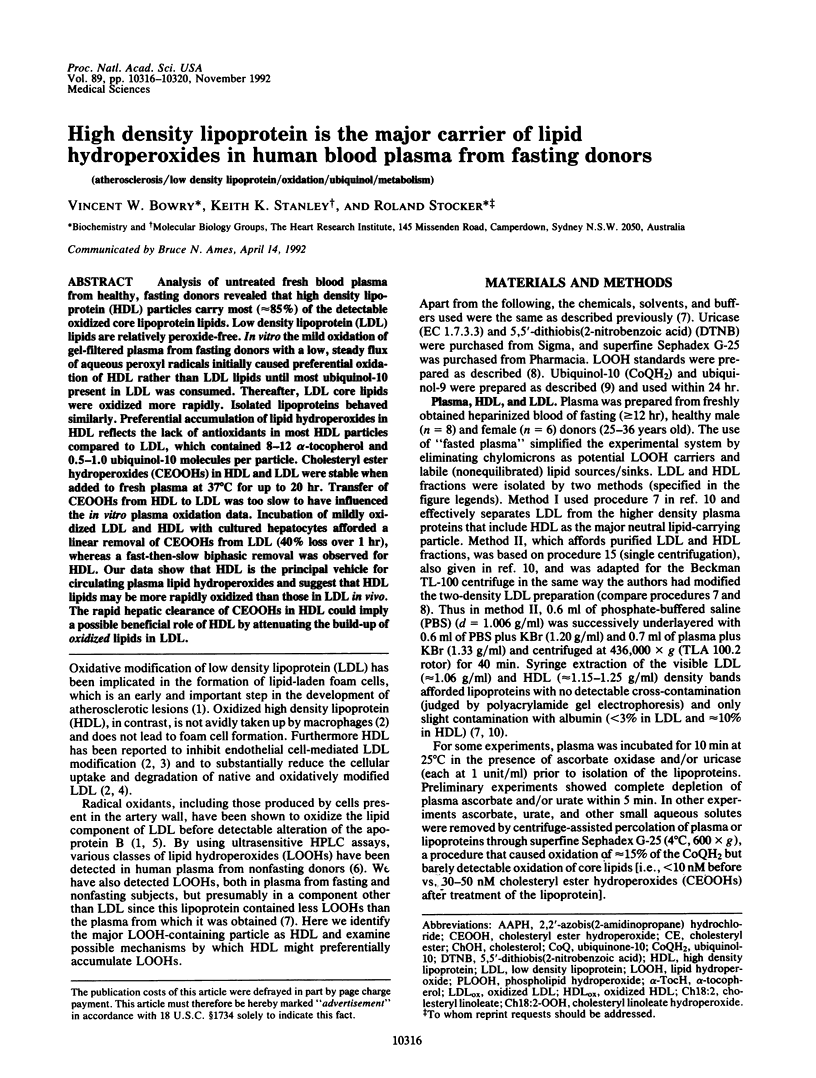
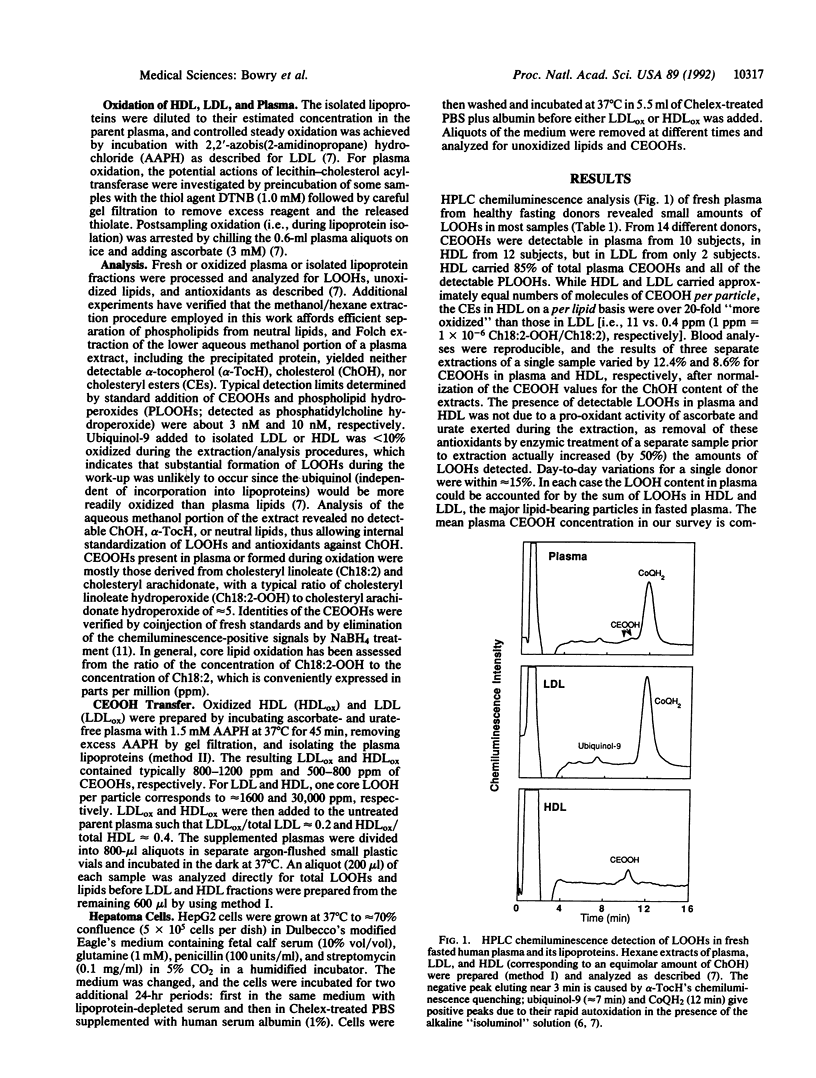
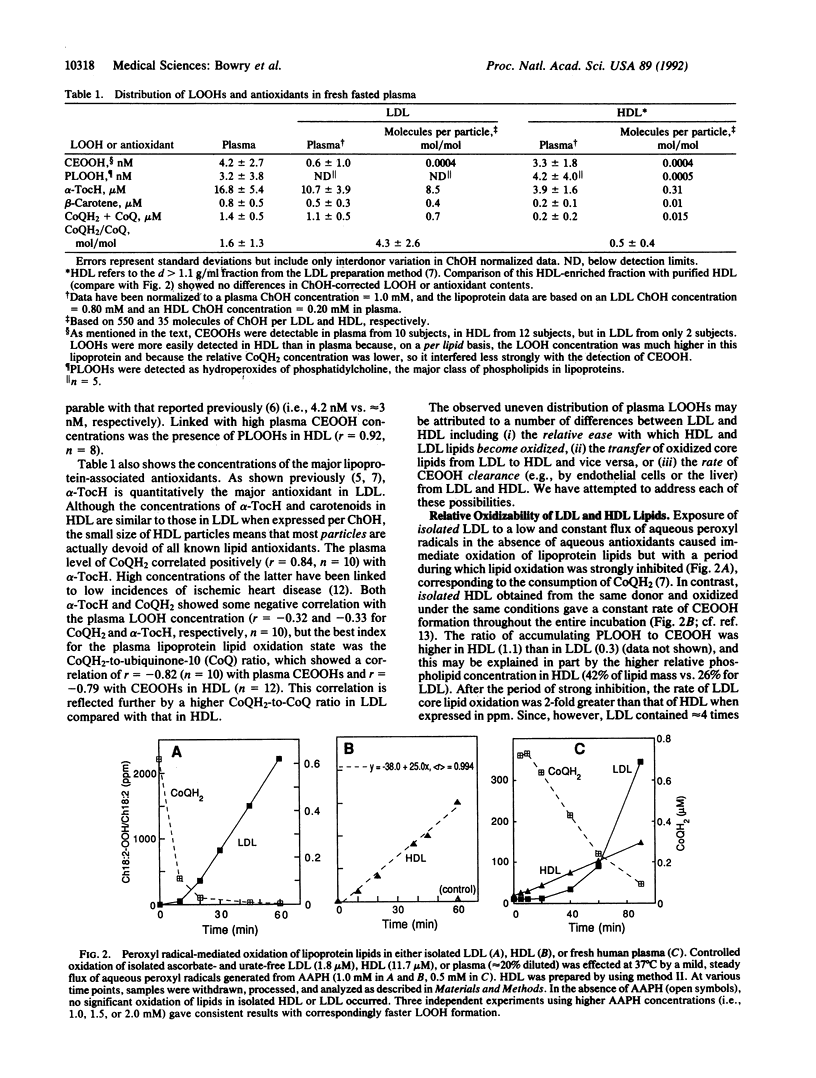
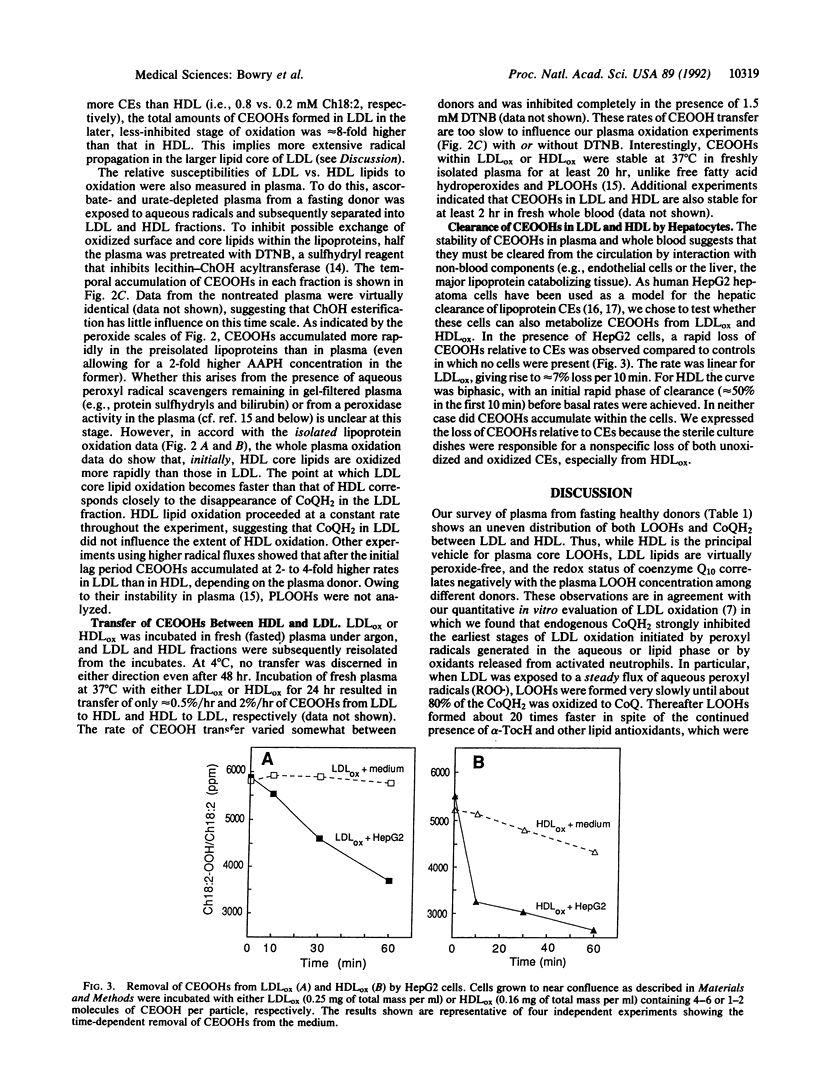
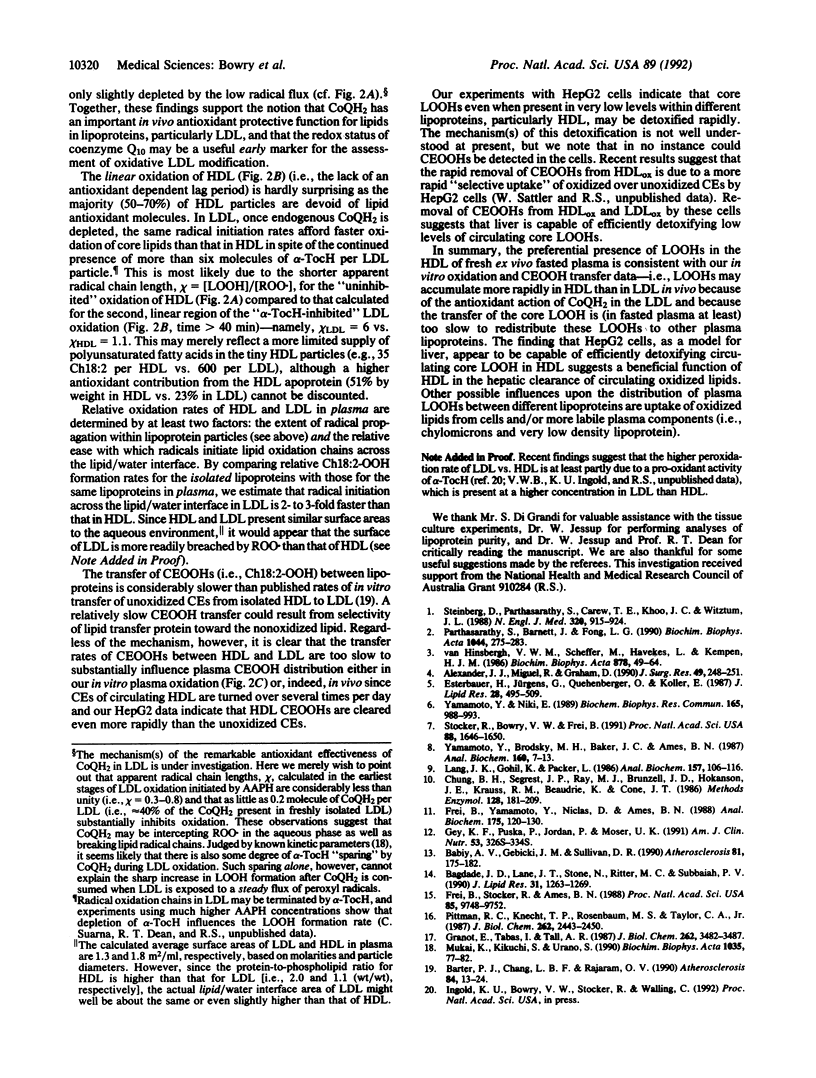
Selected References
These references are in PubMed. This may not be the complete list of references from this article.
- Alexander J. J., Miguel R., Graham D. Competitive inhibition of LDL binding and uptake by HDL in aortic endothelial cells. J Surg Res. 1990 Sep;49(3):248–251. doi: 10.1016/0022-4804(90)90128-o. [DOI] [PubMed] [Google Scholar]
- Babiy A. V., Gebicki J. M., Sullivan D. R. Vitamin E content and low density lipoprotein oxidizability induced by free radicals. Atherosclerosis. 1990 Apr;81(3):175–182. doi: 10.1016/0021-9150(90)90064-p. [DOI] [PubMed] [Google Scholar]
- Bagdade J. D., Lane J. T., Stone N., Ritter M. C., Subbaiah P. V. Persistent abnormalities in lipoprotein composition and cholesteryl ester transfer following lovastatin treatment. J Lipid Res. 1990 Jul;31(7):1263–1269. [PubMed] [Google Scholar]
- Barter P. J., Chang L. B., Rajaram O. V. Sodium oleate promotes a redistribution of cholesteryl esters from high to low density lipoproteins. Atherosclerosis. 1990 Sep;84(1):13–24. doi: 10.1016/0021-9150(90)90003-2. [DOI] [PubMed] [Google Scholar]
- Chung B. H., Segrest J. P., Ray M. J., Brunzell J. D., Hokanson J. E., Krauss R. M., Beaudrie K., Cone J. T. Single vertical spin density gradient ultracentrifugation. Methods Enzymol. 1986;128:181–209. doi: 10.1016/0076-6879(86)28068-4. [DOI] [PubMed] [Google Scholar]
- Esterbauer H., Jürgens G., Quehenberger O., Koller E. Autoxidation of human low density lipoprotein: loss of polyunsaturated fatty acids and vitamin E and generation of aldehydes. J Lipid Res. 1987 May;28(5):495–509. [PubMed] [Google Scholar]
- Frei B., Stocker R., Ames B. N. Antioxidant defenses and lipid peroxidation in human blood plasma. Proc Natl Acad Sci U S A. 1988 Dec;85(24):9748–9752. doi: 10.1073/pnas.85.24.9748. [DOI] [PMC free article] [PubMed] [Google Scholar]
- Frei B., Yamamoto Y., Niclas D., Ames B. N. Evaluation of an isoluminol chemiluminescence assay for the detection of hydroperoxides in human blood plasma. Anal Biochem. 1988 Nov 15;175(1):120–130. doi: 10.1016/0003-2697(88)90369-7. [DOI] [PubMed] [Google Scholar]
- Gey K. F., Puska P., Jordan P., Moser U. K. Inverse correlation between plasma vitamin E and mortality from ischemic heart disease in cross-cultural epidemiology. Am J Clin Nutr. 1991 Jan;53(1 Suppl):326S–334S. doi: 10.1093/ajcn/53.1.326S. [DOI] [PubMed] [Google Scholar]
- Granot E., Tabas I., Tall A. R. Human plasma cholesteryl ester transfer protein enhances the transfer of cholesteryl ester from high density lipoproteins into cultured HepG2 cells. J Biol Chem. 1987 Mar 15;262(8):3482–3487. [PubMed] [Google Scholar]
- Lang J. K., Gohil K., Packer L. Simultaneous determination of tocopherols, ubiquinols, and ubiquinones in blood, plasma, tissue homogenates, and subcellular fractions. Anal Biochem. 1986 Aug 15;157(1):106–116. doi: 10.1016/0003-2697(86)90203-4. [DOI] [PubMed] [Google Scholar]
- Mukai K., Kikuchi S., Urano S. Stopped-flow kinetic study of the regeneration reaction of tocopheroxyl radical by reduced ubiquinone-10 in solution. Biochim Biophys Acta. 1990 Jul 20;1035(1):77–82. doi: 10.1016/0304-4165(90)90176-w. [DOI] [PubMed] [Google Scholar]
- Parthasarathy S., Barnett J., Fong L. G. High-density lipoprotein inhibits the oxidative modification of low-density lipoprotein. Biochim Biophys Acta. 1990 May 22;1044(2):275–283. doi: 10.1016/0005-2760(90)90314-n. [DOI] [PubMed] [Google Scholar]
- Pittman R. C., Knecht T. P., Rosenbaum M. S., Taylor C. A., Jr A nonendocytotic mechanism for the selective uptake of high density lipoprotein-associated cholesterol esters. J Biol Chem. 1987 Feb 25;262(6):2443–2450. [PubMed] [Google Scholar]
- Steinberg D., Parthasarathy S., Carew T. E., Khoo J. C., Witztum J. L. Beyond cholesterol. Modifications of low-density lipoprotein that increase its atherogenicity. N Engl J Med. 1989 Apr 6;320(14):915–924. doi: 10.1056/NEJM198904063201407. [DOI] [PubMed] [Google Scholar]
- Stocker R., Bowry V. W., Frei B. Ubiquinol-10 protects human low density lipoprotein more efficiently against lipid peroxidation than does alpha-tocopherol. Proc Natl Acad Sci U S A. 1991 Mar 1;88(5):1646–1650. doi: 10.1073/pnas.88.5.1646. [DOI] [PMC free article] [PubMed] [Google Scholar]
- Yamamoto Y., Brodsky M. H., Baker J. C., Ames B. N. Detection and characterization of lipid hydroperoxides at picomole levels by high-performance liquid chromatography. Anal Biochem. 1987 Jan;160(1):7–13. doi: 10.1016/0003-2697(87)90606-3. [DOI] [PubMed] [Google Scholar]
- Yamamoto Y., Niki E. Presence of cholesteryl ester hydroperoxide in human blood plasma. Biochem Biophys Res Commun. 1989 Dec 29;165(3):988–993. doi: 10.1016/0006-291x(89)92700-9. [DOI] [PubMed] [Google Scholar]
- van Hinsbergh V. W., Scheffer M., Havekes L., Kempen H. J. Role of endothelial cells and their products in the modification of low-density lipoproteins. Biochim Biophys Acta. 1986 Aug 14;878(1):49–64. doi: 10.1016/0005-2760(86)90343-7. [DOI] [PubMed] [Google Scholar]


